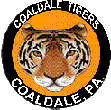Pro football was a very big deal in the 1920s in the anthracite coal region of Pennsylvania.
The team in Pottsville, the Maroons, was the only one that actually joined the NFL (1925-28), but the nearby towns of Coaldale, Shenandoah, Gilberton and Mount Carmel — located just off Interstate 81 today — all fielded clubs that enjoyed beating up on one another.
A game between Shenandoah and Coaldale in November 1922 gives you a glimpse of what the environment was like. Here’s the account that ran in newspapers across the country:
 POTTSVILLE, Pa. — Ten thousand people at a football game at Coaldale near here Sunday afternoon refused to desert the game to fight a fire when the alarm was turned in and, as a result, a house which was located on Railroad Street, a sparsely settled section of the borough, burned to the ground.
POTTSVILLE, Pa. — Ten thousand people at a football game at Coaldale near here Sunday afternoon refused to desert the game to fight a fire when the alarm was turned in and, as a result, a house which was located on Railroad Street, a sparsely settled section of the borough, burned to the ground.
Appeals were made at the game for firemen to respond, but no one budged.
Coaldale tied Shenandoah 6-6.
They took their football seriously in the Coal League. Teams would sign NFL ringers — at salaries as high as $500 a game — to fortify their rosters, and miners would bet large sums on the outcome.
In his book, “Fritz Pollard: Pioneer in Racial Advancement,” John M. Carroll writes: “Until the 1920s, many games in the coal region were never completed because fans on the losing side would start a riot in the final period so they would not lose their wagers. All this changed when Robert ‘Tiny’ Maxwell, a prominent referee and former Swarthmore College player, was brought in to officiate along with two other nationally known officials, Wilmer Crowell and Charles McCarthy.”
But even Maxwell, a 6-foot-4, 300-pound mountain of persuasion, couldn’t put a stop to all mischief. Don Thompson, a guard with the Los Angeles Buccaneers, had this memory of a visit to Pottsville’s Minersville Field in 1926: “I guess our toughest defeat was [there]. There was a quarter of an inch of ice on the puddles in the playing field that had to be broken before the game. The spectators stood on the sidelines and threw chunks of coal at us through the entire contest. We scored four touchdowns that were not allowed.”
Makes you wonder if the Maroons’ home-field advantage might have been the biggest in NFL history. It certainly has to rank somewhere near the top.
“Those miners were great fans,” Pottsville Hall of Famer Fats Henry once said. “They’d approach you on the street, the coal dust on their faces, and talk football with you. If they liked you they’d die for you. But if they didn’t you’d die for them.”
Nobody had better Coal League stories than Mike Palm, a back for the New York Giants who later coached in the NFL. When he wasn’t otherwise occupied in those years, Palm would sneak off to Shenandoah for a weekend of well-paid bleeding on a coal slag-strewn field.
“There wasn’t a blade of grass in the league,” he told Joe King of the New York World-Telegram, “and fans wouldn’t hesitate to participate in the game with rocks, sticks, stones, fists and abuse.
“The teams got the biggest guys they could find in the mines, regardless of football experience, and imported enough collegiate players to rig up an attack. Coaldale had two old fighters, Honeyboy Evans and Blue Bonner, who never forgot their old trade on the gridiron.
“When I played at Shenandoah, we had Frank Kutzko, who looked like [wrestler] Bull Montana and was three times as big. Once against Pottsville, Kutzko picked up Harry Robb, gave him the airplane spin and slammed him down. I rushed up objecting: ‘Don‘t do that, Frank. Do you want them to take it out on us little fellows?’ Kutzko replied: ‘Mike, this is football. If I can kill him, I will kill him.’
“That was the way they played. If one of us collegians threw a pass, someone would surely yell, ‘Cut out that basketball.’”
Which seems as good a place to end as any. This was the Coal League: If I can kill him, I will kill him.
Excerpted by permission from The National Forgotten League: Entertaining Stories and Observations from Pro Football’s First Fifty Years by Dan Daly. Copyright (c) 2012 by Dan Daly. Published by University of Nebraska Press. All rights reserved. No part of this excerpt may be reproduced or reprinted without permission in writing from the publisher. Available wherever books are sold or via University of Nebraska Press (1-800-848-6224). Follow Dan on Twitter @dandalyonsports.
Source: http://www.washingtontimes.com/news/2012/sep/18/of-miners-and-men/?page=all

 POTTSVILLE, Pa. — Ten thousand people at a football game at Coaldale near here Sunday afternoon refused to desert the game to fight a fire when the alarm was turned in and, as a result, a house which was located on Railroad Street, a sparsely settled section of the borough, burned to the ground.
POTTSVILLE, Pa. — Ten thousand people at a football game at Coaldale near here Sunday afternoon refused to desert the game to fight a fire when the alarm was turned in and, as a result, a house which was located on Railroad Street, a sparsely settled section of the borough, burned to the ground.